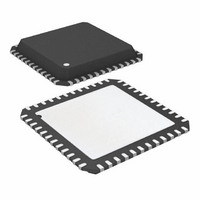AD7650ACP Analog Devices Inc, AD7650ACP Datasheet - Page 17

AD7650ACP
Manufacturer Part Number
AD7650ACP
Description
IC ADC 16BIT CMOS 5V 48-LFCSP
Manufacturer
Analog Devices Inc
Datasheet
1.AD7650ACPZRL.pdf
(20 pages)
Specifications of AD7650ACP
Rohs Status
RoHS non-compliant
Number Of Bits
16
Sampling Rate (per Second)
570k
Data Interface
Serial, Parallel
Number Of Converters
1
Power Dissipation (max)
77mW
Voltage Supply Source
Analog and Digital
Operating Temperature
-40°C ~ 85°C
Mounting Type
Surface Mount
Package / Case
48-VFQFN, CSP Exposed Pad
For Use With
EVAL-AD7650CBZ - BOARD EVALUATION FOR AD7650
MICROPROCESSOR INTERFACING
The AD7650 is ideally suited for traditional dc measurement appli-
cations supporting a microprocessor, and ac signal processing
applications interfacing to a digital signal processor. The AD7650
is designed to interface either with a parallel 16-bit-wide interface or
with a general-purpose serial port or I/O ports on a microcontroller.
A variety of external buffers can be used with the AD7650 to
prevent digital noise from coupling into the ADC. The following
sections illustrate the use of the AD7650 with an SPI-equipped
microcontroller, the ADSP-21065L and ADSP-218x signal
processors.
SPI Interface (MC68HC11)
Figure 18 shows an interface diagram between the AD7650 and an
SPI-equipped microcontroller like the MC68HC11. To accom-
modate the slower speed of the microcontroller, the AD7650 acts
as a slave device and data must be read after conversion. This mode
allows also the “daisy chain” feature.
The convert command could be initiated in response to an internal
timer interrupt. The reading of output data, one byte at a time,
if necessary, could be initiated in response to the end-of-conversion
signal (BUSY going low) using to an interrupt line of the
microcontroller. The Serial Peripheral Interface (SPI) on the
MC68HC11 is configured for master mode (MSTR = 1), Clock
Polarity Bit (CPOL) = 0, Clock Phase Bit (CPHA) = 1 and SPI
Interrupt Enable (SPIE = 1) by writing to the SPI Control Reg-
ister (SPCR). The IRQ is configured for edge-sensitive-only
operation (IRQE = 1 in OPTION register).
OVDD
DVDD
CS
INVSCLK
RD
SER/PAR
EXT/INT
AD7650
ADDITIONAL PINS OMITTED FOR CLARITY
SDOUT
CNVST
BUSY
SCLK
IRQ
MISO/SDI
SCK
I/O PORT
MC68HC11
ADSP-21065L in Master Serial Interface
As shown in Figure 19, the AD7650 can be interfaced to the
ADSP-21065L using the serial interface in master mode without
any glue logic required. This mode combines the advantages of
reducing the number of wire connections and being able to read
the data during or after conversion at user convenience.
The AD7650 is configured for the internal clock mode (EXT/INT
low) and acts, therefore, as the master device. The convert com-
mand can be generated by either an external low jitter oscillator
or, as shown, by a FLAG output of the ADSP-21065L or by a
frame output TFS of one serial port of the ADSP-21065L which
can be used as a timer. The serial port on the ADSP-21065L is
configured for external clock (IRFS = 0), rising edge active
(CKRE = 1), external late framed sync signals (IRFS = 0, LAFS = 1,
RFSR = 1) and active high (LRFS = 0). The serial port of the
ADSP-21065L is configured by writing to its receive control
register (SRCTL)—see ADSP-2106x SHARC User’s Manual.
Because the serial port within the ADSP-21065L will be seeing
a discontinuous clock, an initial word reading has to be done
after the ADSP-21065L has been reset to ensure that the serial
port is properly synchronized to this clock during each following
data read operation.
OGND
OVDD
OR
DVDD
CS
INVSCLK
INVSYNC
SER/PAR
RDC/SDIN
RD
EXT/INT
AD7650
ADDITIONAL PINS OMITTED FOR CLARITY
SDOUT
CNVST
SYNC
SCLK
RFS
DR
RCLK
FLAG OR TFS
ADSP-21065L
AD7650
SHARC












